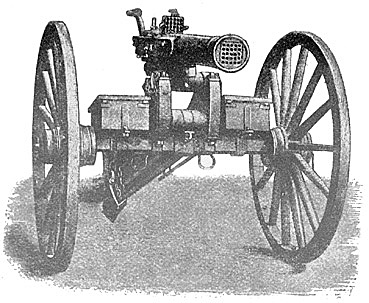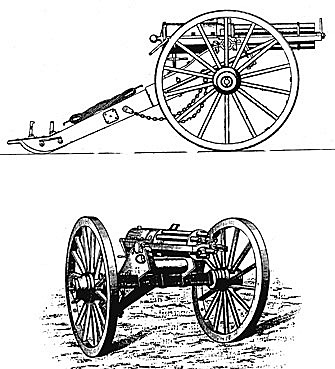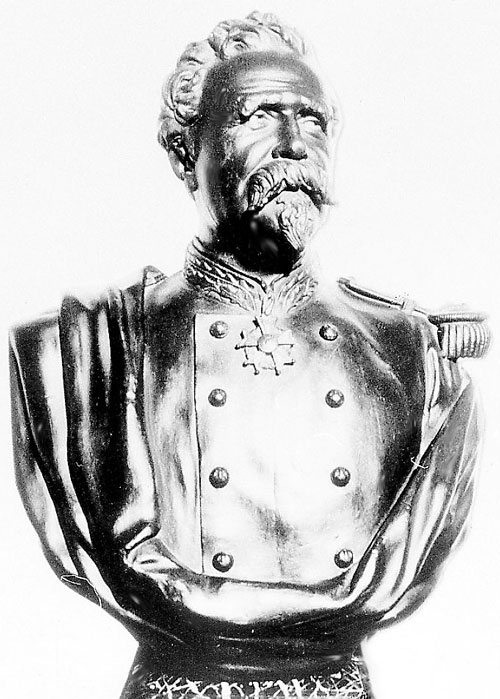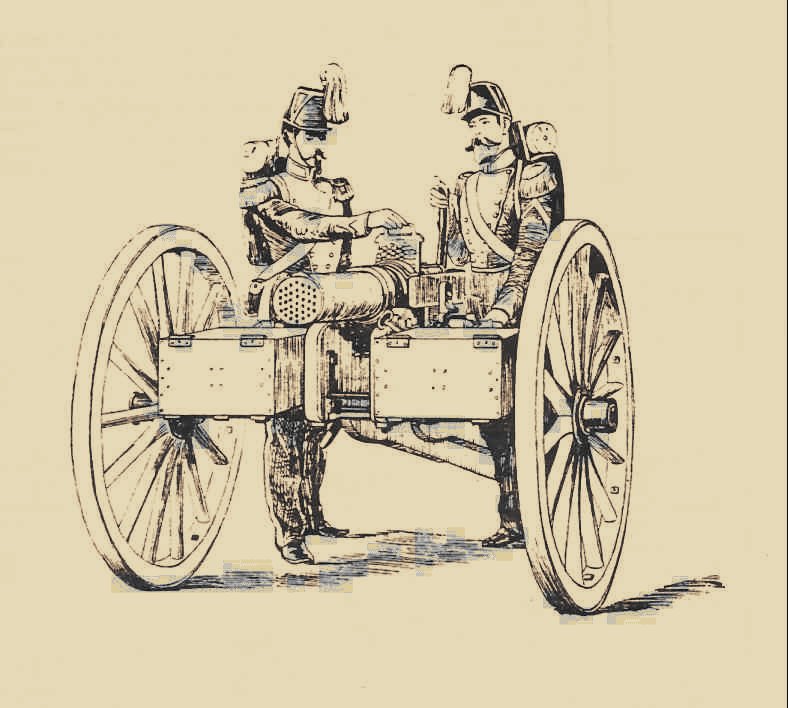
|
|||||||||||||||||||||||||||||||||||||||||||||||||||||
Il est des armes qui font office de vilains petits canards. Parfois ces armes auront une carrière bien remplie parfois elles tombèrent dans les oubliettes de l’Histoire parfois elle eurent une carrière en demi teinte à cause d’une mauvaise conception ou d’une mauvaise utilisation de l’arme.
L arme qui vous est présenté ici fait partie de cette derniere catégorie. Historique L'idée d’assembler plusieurs canons côte à côte pouvant tirer en rafale n'est pas nouvelle. Nous le trouvons chez les Asiatiques notamment en Corée et au Japon et au Moyen Âge en France le ribaudequin ou mantelet était un canon rassemblant quatre petits canons montés sur un chariot à deux roues protégé par un bouclier en bois Le chariot avait des fauchards et le bouclier était hérissé de piques cela pour protéger l’équipe de pièces des assauts Nous trouvons ensuite en 1630 un dessin qui montre de modèles de ribaudequins perfectionnés appelés orgues toujours montés sur des châssis en bois à roues ce qui les rend mobiles . Apres cela plus rien et il faut attendre le XIXe siècle et 1862 pour voir une arme qui sera appelée mitrailleuse de par son inventeur l'américain R.J Gatling. C'était une arme à 8 canons rotatifs popularisée par les Western Spaghetti. Toutefois cette arme n'était pas du tout précise car la rotation des canons avec une manivelle produit une dispersion de la salves
Cette arme fut présentée en 1867 à l'exposition universitaire universelle de Paris où elle attira l'attention de Napoléon III qui l’a fit essayer à Versailles Qui était son inventeur
Jean Baptiste Verchères de Reffye. est né à Strasbourg le 3 juillet 1821. Il intégra Polytechnique en 1841 et ensuite passa par l'école d'application d'artillerie de Metz.
Le corps du canon en bronze semblable à aux canons de 4 reçoit dans son âme une pièce comprenant 25 tubes d'un calibre de 13 mm. La pièce maîtresse est le mécanisme de culasse qui est constitué des percuteurs et du système de mise à feu. Entre le canon et la culasse mobile on engage dans les 25 canons une plaquette de 25 cartouches
Comme écrit précédemment suite à la déclaration de guerre du 16 juillet les autorités décident d’employer ces canons à balles les 215 pièces construites et stockées à Meudon Mont valérien Forts d’Issy les Moulineaux et de Montrouge furent donc livrées aux régiments d’artillerie .30 batteries furent mises sur pied mais on préleva les effectifs des régiments d’artillerie pour armer 23 batteries destinées à former l’artillerie de la Garde Impériale En effet les mitrailleuses de style Gatling ou le canon revolver Hotchkiss surclassent rapidement ce type d’arme
Caractéristiques
Voir Aussi Autres Photoscopes See Also Others Walk Around The bullets gun Reffye.
It is weapons that act as naughty little ducks. Sometimes these weapons will have a busy career sometimes they fell into history oubliettes sometimes she had a career in the semi shade because of improper design or use of this weapon.
The weapon that is presented to you today is part of this last category. History The idea to assemble some guns side by side shooting in burst is not new. We find this weapon among Asians especially in Korea and Japan and in the Middle Age in France with the ribaudequin or mantelet was a gun with four smalls guns mounted on a two-wheeled chariot protected by a wooden shield The trolley had double edged slasher and the shield bristling with pikes to protect this team during assaults We find in 1630 drawing showing sophisticated models of ribaudequins called organs still mounted on wooden frames wheeled making them mobile. After that nothing and it was not until the 19th century and 1862 to see a weapon that will be called machine gun by his inventor RJ Gatling who his American It was a weapon with 8 rotary barrels popularized by the Spaghetti Western film in the 70th . However, this weapon was not at all accurate because the rotation of guns with a crank produces a dispersion of the volley
This weapon was introduced in 1867 at the Universal Exhibition in Paris , where she attracted the attention of Napoleon III that a fit trying to Versailles
Two copies were purchased by french while the King of Prussia order 3 for its police. This order was followed by an additional order for 97 copies. The Gatling also interested Austria Bavaria Britain Italy Switzerland and the Netherlands and Japan, but none of these countries did not receive weapons. But in France a new weapon will make its appearance. It will be called the Reffye bullet gun Who was the inventor ?
Jean Baptiste de Verchères Reffye.was born in Strasbourg on July 3rd of 1821. He joined Polytechnique in 1841 and then went through the school of application artillery Metz.
He was appointed a second lieutenant in 1848 and in 1853 he was assistant to the manufacture of weapons of Tulle He was a man imaginative and worker, but he had been assigned in an arms factory because it had been deemed unfit by his superiors in command of troops However en1858 he was appointed aide-de-camp of the Emperor Interested by gun since 1863 he has pursued the study of a piece of 4 and began the study of his famous bullet gun. A commission chaired by General Leboeuf then developed the basic principles of the weapon. The tube was to be composed of several barrels which each of them should have the same regularity that any shooting overall. The caliber of the weapon must be 13 mm. The use of this tactic weapon remained to be determined, including the crew. On May 7th 1864 the first note was delivered to the Emperor Napoleon III. Already the main characteristics of the weapon are defined. The weapon will have a cariage as a gun. The steel tubes will have a mobile breech closed by a yoke against which must be firing. The ball size 13 mm weighs 50 grams and has a warhead of 12 grams. Napoleon III agrees and construction of the prototype is decided on May 24th 1864. The manufacturing costs will be borne by the personal cassette of the emperor. To keep the secret components of the weapons are manufactured by various workshops The tubes are manufactured by a Parisian civil company while setting of the barrels in the the tube was made by the military Meudon workshop who in at the same time built breechc. The carriages were built in Paris by civilian factories . But the artillery Central Depot is responsible for the manufacture of ammunition boxes. . Soon after it was decided to launch the production of a series of 100 pieces. But the price of the series far exceeds the capacity of the Fund secret of the Emperor. We must therefore look to the military and claim a credit on the central budget of the artillery which had largely funds In September 1865 the Director General of Artillery General Suzanne refuses to release the funds, but an order from the Emperor unfreeze the situation Money his released and parts manufacturing can begin. As the pieces were finished they were tested at Meudon and stored in sheds, the keys to which were entrusted to Reffye He was drafted an instruction manual for the service of the weapon firing tables. Always But under the secrecy of these instructions were distributed in case of conflict. Even the shooting were in the greatest secrecy at the polygon of Versailles This weapon was concealed for so therefore to every body that it was only on July 20th 1870 or 2 weeks after the declaration of war against al Prussia that the first pieces arrived in regiment In retrospect it is believed that if the secret to this armed be lifted sooner it would have been at its most efficient . Functioning
It is a weapon rather rustic but also complicated at the same time
The bronze barre is similar to the guns of 4 receives on this interior 25 tubes calibre 13 mm. The master piece is the breech mechanism which consists on percuteurs system and fuze. Between the barrel and mobile breech we introduce in the 25 guns a booklet of 25 cartridges To put it a crank axial make backing the mechanism of the breech to the pad and then introduced the booklet and after squeeze everything after the introduction of cartridges The mechanism of the breech consists of a square piece of steel pierced with 25 losing units for hammers just rely on the springs that will allow percussion. These are strained by a crank called clamp placed on the right side of the breech The release of 25 hammers was caused by a plate fitted with grooves, which compresses up springs and prevent unintended firing. The firing is controlled by a crank on the right side of the breech led to a screw allow the fire:In oder to fire 1st 4th 2nd 5th 3rd In three and a half laps of the crank salve is released . The handle breech carry away back the entire system of the percussionng allowing the withdrawal of the plate pulled and the introduction of the new booklet . On the barrel mounted on trunnion can be moving on site like screws like the other guns. On each side of the barrel are arranged on axles 2 boxes containing on the right percussive recharge hammers springs 2 red boxes of 25 rounds while the left is 2 breechs 2 boxes of 25 red cartridges and various accessories. Finally on the carriage arrow in the 3rd box you found a mobile breech On the side of the carriage is the set of tools. The cannon ball was coupled by an ocular to the central part of the train before similar at the gun standard M 1858 He was accompanied by a box containing boxes ammunition specially designed for the transport of this ammunition. These boxes are also coupled to a train before for gun M1858. They take in 2 compartments 4050 cartridges divided into 162 booklets, which are 2 types Cartridges green mono bullets( 1800 cartridges ) and red cartridges with military heads to 3 balls (4500 cartridges ). The divisional park has 400 bursts (400x25 = 10000 cartridges) per piece on trolleys and a level 3rd refuelling level was planned at the AClevel with 400 rounds again. The crew of a battery was 118 officers, non-commissioned officers and troops serving 64 horses for all Each battery was composed of six systems with six boxes of 48 boxes led by 24 gunners drivers . On each before train were seated gunners The 18 drivers and 16 servants are divided on servitude vehicles that followed the artillery pieces The cannon balls and the War of 1870 / 1871
At the declaration of war on July 16th , the authorities decide to use these 215 guns bullets built and stored in Meudon Mont Valerien ,Forts Issy les Moulineaux and therefore Montrouge . They were delivered to artillery regiments. 30 batteries were createdp but it was took on normal artillery regiments men to arm 23 artillery batteries meant for artillery of the Imperial Guard
But no instruction manual or tactic had been planned and the number of officers designated to order its batteries did not even know to use it The Prussians who were aware of this secre weapon sought by every means to destroy them by firing counter battery The only time they were properly used these pieces made ravage in the ranks of Prussian troops The August 14th they stop it Borny several Prussian columns bis répétita the 16 at Sedan and Metz very this weapons have been used successfully. The 94 remaining pieces were delivered to the enemy, but the weapons had been sabotaged The fall of the 2sd Empire do not involve the use of this weapon and November 3rd 1870 were created 12 batteries of cannons ball for the National Guard as some departments Charente, Charente lower Deux-Sèvres Gironde Maine - et-Loire and the Basses Pyrenees Some of the batteries used in the army Loire along with Gatling guns For Paris there remained only four guns A total of 36 guns were built between September 1870 and February 1871 After the war the Artillery Committee was almost entirely in favour of this gun bullets while acknowledging its lack of coverage by classical canon But despite the glowing reports systems were kept in reserve corps and was not built in large quantity Indeed, the style Gatling MG or Hotchkiss Gun revolver outperform quickly this type of weapon Specifications
Voir Aussi Autres Photoscopes See Also Others Walk Around
|
|
Droit d’auteur La plupart des photographies publiées sur ce site sont la propriété exclusive de © Claude Balmefrezol Elles peuvent être reproduites pour une utilisation personnelle, mais l’autorisation préalable de leur auteur est nécessaire pour être exploitées dans un autre cadre (site web publications etc) Les sources des autres documents et illustrations sont mentionnées quand elles sont connues. Si une de ces pièces est protégée et que sa présence dans ces pages pose problème, elle sera retirée sur simple demande. Principaux Collaborateurs:
Nb
de visiteurs:7874148 Nb
de visiteurs aujourd'hui:396 Nb
de connectés:86 | |||||||||||||||||||||||||||||||||||||||||||||||||||













.JPG)
.JPG)
.JPG)
.JPG)
.JPG)
.JPG)
.JPG)
.JPG)
.JPG)




.jpg)
.jpg)
.jpg)
